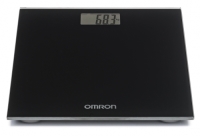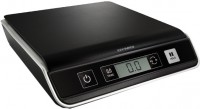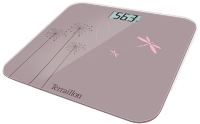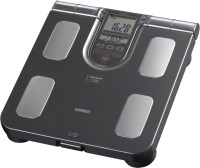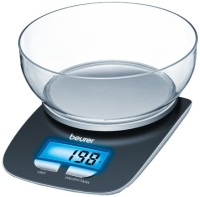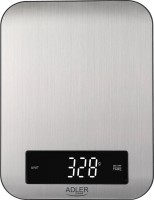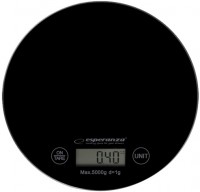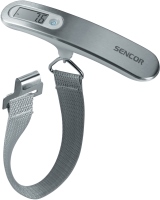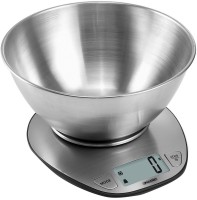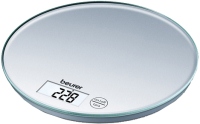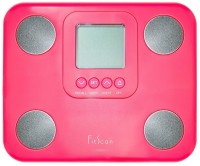Scales Salter
All Scales Advanced filters → |
You might be interested in
Articles, reviews, useful tips
All materials
What to give a tech geek?
Interesting gift options for people who are passionate about gadgets and modern technologies

What to give a boyfriend?
Optimal and universal gifts for a boyfriend depending on his hobbies and desires
Scales: specifications, types
Scales type
— Floor. Scales designed primarily to measure the weight of the human body. According to the name, they are designed for installation on the floor. Advanced models, in addition to the actual mass, can also measure and calculate a number of additional diagnostic parameters: height, percentage of water content in the body, fat/bone tissue, body mass index, etc. (see below for more details).
— Kitchen. Scales intended primarily for measuring the weight of foodstuffs; they are indispensable if you prefer to cook exactly according to recipes, or are engaged in dishes that require precise proportions. Additional functions of such scales mainly include tare compensation.
— Pocket. Pocket scales, recognized for their small size and specific design, typically feature an elongated body with a central element for hanging loads, such as a hook or loop. This construction enables the scales to be suspended from the load, akin to holding a handle, and determines mass based on the force exerted on the suspension. Despite their compactness, which lends itself to easy portability (hence the name "pocket scales"), these devices can deliver notable accuracy, with divisions ranging from 10 to 100 grams. Their maximum weight capacity (refer to "Measurement weight" below) can extend up to 50 kg, often sufficient for most handheld loads. Pocket scales prove advantageous in vario...us scenarios, including purchasing large quantities of produce or bulk items, weighing luggage before air travel, and more.
— Baby scales, designed for weighing newborns and young children who are not yet able to stand on their feet. The platform of such scales is a tray with characteristic sides, in which you can put the baby on his back without fear that he will slip off the scales (although leaving the child unattended on such a surface is still not worth it). The maximum weight of measurements in such devices is about 10 – 20 kg — this is more than enough for their main purpose.
— Spoon-scales. A kitchen gadget called a "spoon scale" seamlessly integrates a spoon and a scale. Essentially, it's a measuring spoon with a built-in scale display and weighing mechanism within the handle. This tool offers evident convenience, allowing users not only to estimate liquids or bulk items visually but also to instantly ascertain their precise weight. This proves especially useful when meticulous ingredient measurement is necessary, particularly in complex recipe preparations.
— Kitchen. Scales intended primarily for measuring the weight of foodstuffs; they are indispensable if you prefer to cook exactly according to recipes, or are engaged in dishes that require precise proportions. Additional functions of such scales mainly include tare compensation.
— Pocket. Pocket scales, recognized for their small size and specific design, typically feature an elongated body with a central element for hanging loads, such as a hook or loop. This construction enables the scales to be suspended from the load, akin to holding a handle, and determines mass based on the force exerted on the suspension. Despite their compactness, which lends itself to easy portability (hence the name "pocket scales"), these devices can deliver notable accuracy, with divisions ranging from 10 to 100 grams. Their maximum weight capacity (refer to "Measurement weight" below) can extend up to 50 kg, often sufficient for most handheld loads. Pocket scales prove advantageous in vario...us scenarios, including purchasing large quantities of produce or bulk items, weighing luggage before air travel, and more.
— Baby scales, designed for weighing newborns and young children who are not yet able to stand on their feet. The platform of such scales is a tray with characteristic sides, in which you can put the baby on his back without fear that he will slip off the scales (although leaving the child unattended on such a surface is still not worth it). The maximum weight of measurements in such devices is about 10 – 20 kg — this is more than enough for their main purpose.
— Spoon-scales. A kitchen gadget called a "spoon scale" seamlessly integrates a spoon and a scale. Essentially, it's a measuring spoon with a built-in scale display and weighing mechanism within the handle. This tool offers evident convenience, allowing users not only to estimate liquids or bulk items visually but also to instantly ascertain their precise weight. This proves especially useful when meticulous ingredient measurement is necessary, particularly in complex recipe preparations.
Mechanism
— Mechanical. One of the simplest weighing systems, known for a long time and has not lost popularity to this day. Typically operating on the spring principle, this design features a scale platform that compresses a spring as weight is applied (with greater weight resulting in stronger compression). An attached arrow displays measurement outcomes on the scale. Mechanical models boast simplicity, affordability, and independence from power sources, rendering batteries or outlets unnecessary. However, achieving high measurement precision proves challenging in such devices; even the most precise kitchen models offer divisions of around 10 grams. Furthermore, additional features such as voice notification are not feasible for mechanical scales. As a result, this design is predominantly found in budget-friendly floor and kitchen scales intended for simple use.
— Electronic. These weighing systems are founded on electronic pressure sensors (such as magnetic or pneumatic sensors) along with specialized circuits responsible for data processing and display. Compared to mechanical scales, electronic scales are notably more complex and expensive. They require a regular supply of batteries or recharging, depending on the model. However, electronic scales excel over mechanical counterparts in terms of accuracy, functionality, and overall user convenience. While mechanical scales w...ith arrows need to be read from a strictly perpendicular angle to avoid misinterpretation, electronic scales display their readings without such difficulties. Additional features are extensively covered in the "Functions" section, with many of these functions being exclusive to electronic scales. Notably, electronic scales are the preferred choice for accuracy-sensitive tasks, such as jewelry weighing, where measurements extend to tenths and hundredths of a gram (for more details, see "Type of scales").
— Electronic. These weighing systems are founded on electronic pressure sensors (such as magnetic or pneumatic sensors) along with specialized circuits responsible for data processing and display. Compared to mechanical scales, electronic scales are notably more complex and expensive. They require a regular supply of batteries or recharging, depending on the model. However, electronic scales excel over mechanical counterparts in terms of accuracy, functionality, and overall user convenience. While mechanical scales w...ith arrows need to be read from a strictly perpendicular angle to avoid misinterpretation, electronic scales display their readings without such difficulties. Additional features are extensively covered in the "Functions" section, with many of these functions being exclusive to electronic scales. Notably, electronic scales are the preferred choice for accuracy-sensitive tasks, such as jewelry weighing, where measurements extend to tenths and hundredths of a gram (for more details, see "Type of scales").
Minimum measurement weight
The minimum weight limit at which the scale's readings must align with the specified margin of error is referred to as the minimum load parameter. While theoretically the scale can display measurements below this threshold, the reliability of results can't be guaranteed due to the extremely low load on the sensors in the device's design. The minimum load requirement is primarily determined by the type and intended use of the scales. For instance, kitchen models typically have a range of a few grams, floor scales start at a couple of kilograms, and commodity warehouse scales might begin at 10-15 kg.
Max. measurement weight
The largest weight that is allowed to be placed on the platform of this scale model. If this parameter is exceeded, the scales, at best, will not be able to show the correct data, at worst, they will completely fail. Obviously, the maximum weight is directly related to the purpose, but even kitchen scales can weigh both up to 5 kg and up to 20 kg.
Actually, floor scales have the largest maximum measurement weight, in such models it can reach 200 kg or even more. And the most delicate are jewelry models (refer to "Type"). Also note that in mechanical devices (refer to "Mechanism") the scale is usually graduated to the maximum weight.
Now on the market there are scales with such a maximum weight: up to 1 kg, up to 5 kg, up to 10 kg, up to 50 kg, up to 150 kg, up to 200 kg.
Actually, floor scales have the largest maximum measurement weight, in such models it can reach 200 kg or even more. And the most delicate are jewelry models (refer to "Type"). Also note that in mechanical devices (refer to "Mechanism") the scale is usually graduated to the maximum weight.
Now on the market there are scales with such a maximum weight: up to 1 kg, up to 5 kg, up to 10 kg, up to 50 kg, up to 150 kg, up to 200 kg.
Scale division
Scale division value. Initially, the term "scale division" referred only to mechanical devices (see "Mechanism") and meant the distance between divisions on a scale; however, out of habit, they began to use it for electronic scales. Moreover, both there and there the meaning of this parameter is the same — in fact, it directly describes the accuracy of measurements. For example, if the division value is 1 g, the weight on such devices can be measured with an accuracy of 1 g, regardless of whether it is a mechanical model or an electronic one.
Theoretically, the lower the division value, the more accurate the measurements and the more advanced the device is. On the other hand, high accuracy has a corresponding effect on the price, although in some situations it is not required in principle. So when choosing it is worth considering the features of the application of the device. For example, a kitchen scale with a division value of 0.5 – 1 g will be indispensable for a sophisticated cooker who cooks according to complex recipes with an abundance of ingredients in a small dosage; and for ordinary household cooking on a large scale, an accuracy of 10–20 g is quite enough. But there are also cases when, over the entire measurement range, the division value changes. So for more correct measurements (low weight), the accuracy can be measured in units of grams, for average values — in tens of grams, and already for heavyweights, where an er...ror of 50 – 100 grams is not so critical, even in hundreds of grams. In such cases, we have a value for the general average range in the catalog (if we take into account the floor, then this is approximately for a person of 70 kg).
Theoretically, the lower the division value, the more accurate the measurements and the more advanced the device is. On the other hand, high accuracy has a corresponding effect on the price, although in some situations it is not required in principle. So when choosing it is worth considering the features of the application of the device. For example, a kitchen scale with a division value of 0.5 – 1 g will be indispensable for a sophisticated cooker who cooks according to complex recipes with an abundance of ingredients in a small dosage; and for ordinary household cooking on a large scale, an accuracy of 10–20 g is quite enough. But there are also cases when, over the entire measurement range, the division value changes. So for more correct measurements (low weight), the accuracy can be measured in units of grams, for average values — in tens of grams, and already for heavyweights, where an er...ror of 50 – 100 grams is not so critical, even in hundreds of grams. In such cases, we have a value for the general average range in the catalog (if we take into account the floor, then this is approximately for a person of 70 kg).
Units of measurement
Weights are able to keep records in various units of measurement, while accounting can be done both by mass and by volume. Among the most common units of measurement, we highlight the following.
— Grams (g) — a unit of weight that belongs to the metric system. Grams are used in desktop kitchen scales.
— Kilograms (kg) — a unit of weight that belongs to the metric system. Kilograms are used in floor weighing equipment.
— Pounds (lb:oz) is a common unit of weight used in some countries in Europe, as well as in the United States. 1 pound can be equated to 0.45 kilograms.
— Milliliters (ml) — a unit of volume that belongs to the metric system. Some models of scales are able to determine the volume of milk and water based on mass.
— Ounces (fl'oz) is a unit of volume used in English-speaking countries. 1 US ounce is equivalent to 30 mL.
— Stones (st) is the British unit of weight. Stones are used to take into account the mass of the human body, so this measurement system is found in floor household and specialized diagnostic scales. 1 stone can be equated to 6.35 kilograms.
— Grams (g) — a unit of weight that belongs to the metric system. Grams are used in desktop kitchen scales.
— Kilograms (kg) — a unit of weight that belongs to the metric system. Kilograms are used in floor weighing equipment.
— Pounds (lb:oz) is a common unit of weight used in some countries in Europe, as well as in the United States. 1 pound can be equated to 0.45 kilograms.
— Milliliters (ml) — a unit of volume that belongs to the metric system. Some models of scales are able to determine the volume of milk and water based on mass.
— Ounces (fl'oz) is a unit of volume used in English-speaking countries. 1 US ounce is equivalent to 30 mL.
— Stones (st) is the British unit of weight. Stones are used to take into account the mass of the human body, so this measurement system is found in floor household and specialized diagnostic scales. 1 stone can be equated to 6.35 kilograms.
Functions
— Tare compensation. The capacity to factor in the weight of containers or packaging when weighing materials is a common feature. Typically, this function operates by placing an empty container (like a box or measuring cup) onto the scale and resetting the scale's measurement (via a button press or a specific knob turn). Consequently, when the container is filled, the scale displays only the content's weight, excluding the container's weight. Some models even allow for manual adjustment of any additional weight that shouldn't be considered.
— Measurement of volume. The capability to measure liquid volume is a function present exclusively in kitchen scales (as outlined in "Weighing type"). It's executed through various methods. For instance, some models incorporate a divided bowl that functions as a measuring cup, operating on a similar principle. In other models, users can select the liquid type (water, milk, vegetable oil, etc.), and the scale will automatically compute the volume based on its weight. This function proves valuable when precise ingredient measurement is of utmost importance.
— Automatic activation. Automatic activation of electronic scales when a load is placed on them. Small, but quite handy option.
— Automatic shutdown. This function ensures that the electronic balance (see "Mechanism") turns...off some time after the load has been removed from it. Thanks to auto-off, you can not be afraid to run out of batteries by forgetting to turn off the device. And in some models, manual shutdown is not provided at all — only automatic.
— Voice notification. Scales incorporating a voice notification feature offer audible results, typically relayed through the device's speaker. This function is commonly found in bathroom scales (as discussed in "Type of scales"), where it holds significant relevance. It caters to users who may have difficulty viewing the display without leaning or those who might find leaning inconvenient or impractical due to health issues. Voice notifications can be provided in various languages, allowing users to select their preferred language from the available options.
— Calorie calculator. This function enables the calculation of the nutritional content of weighed items, typically focusing on calorie count, although more advanced models might incorporate additional parameters like protein, fat, carbohydrates, fiber, and liquids. The scale stores information about the nutritional values of various products. When weighing, users select a specific item from this list to determine its caloric content. While theoretically useful for those meticulously monitoring their diet and calorie intake, the accuracy of the calorie calculator often provides only approximations, which may not align precisely with actual values. For instance, while the calorie calculator can accurately estimate the nutritional value of fruits and vegetables, it tends to provide general average values for grains. However, the actual calorie content of foods like porridge varies based on preparation methods. Thus, the calorie calculator should not be solely relied upon; for more precise nutritional information, consulting specialized tables and calculation methods is advisable.
— Timer. Including a timer feature in scales enables users to set countdown intervals. The user establishes a desired duration, initiates the timer, and receives a signal when the set time elapses. This functionality proves beneficial across various applications, with particular utility in the kitchen where precise time control is frequently required during cooking. Consequently, the majority of scales equipped with a timer are categorized as kitchen scales (refer to "Type of scales").
— Thermometer. Availability of the built-in thermometer in scales. Usually, this function is performed by a simple thermal sensor that determines the ambient temperature; and most scales with such equipment are kitchen scales or floor scales (refer to "Type of scales"). Note that in fact, the need for a thermometer occurs relatively rarely, and this function is more of a “nice addition” than a serious functional advantage. However, such equipment has almost no effect on the cost of scales — thermal sensors are very inexpensive.
— Synchronization with a smartphone. The capacity to link scales with a mobile device (smartphone, tablet) for data exchange is a prevalent feature. Generally, this involves installing a designated application, which might even be provided alongside the scales. The specifics of this connection and its functionalities can vary, contingent on the type and model of the scale. This feature is commonly found in floor-standing diagnostic scales, where measurement data is used to maintain a record of body information. It particularly benefits athletes, fitness enthusiasts, and individuals using physical activity for therapeutic purposes. Notably, compatibility extends beyond proprietary software to encompass third-party medical and fitness services. Another category of devices featuring synchronization capability is kitchen scales, where the accompanying application is employed for working with various culinary recipes.
— Measurement of volume. The capability to measure liquid volume is a function present exclusively in kitchen scales (as outlined in "Weighing type"). It's executed through various methods. For instance, some models incorporate a divided bowl that functions as a measuring cup, operating on a similar principle. In other models, users can select the liquid type (water, milk, vegetable oil, etc.), and the scale will automatically compute the volume based on its weight. This function proves valuable when precise ingredient measurement is of utmost importance.
— Automatic activation. Automatic activation of electronic scales when a load is placed on them. Small, but quite handy option.
— Automatic shutdown. This function ensures that the electronic balance (see "Mechanism") turns...off some time after the load has been removed from it. Thanks to auto-off, you can not be afraid to run out of batteries by forgetting to turn off the device. And in some models, manual shutdown is not provided at all — only automatic.
— Voice notification. Scales incorporating a voice notification feature offer audible results, typically relayed through the device's speaker. This function is commonly found in bathroom scales (as discussed in "Type of scales"), where it holds significant relevance. It caters to users who may have difficulty viewing the display without leaning or those who might find leaning inconvenient or impractical due to health issues. Voice notifications can be provided in various languages, allowing users to select their preferred language from the available options.
— Calorie calculator. This function enables the calculation of the nutritional content of weighed items, typically focusing on calorie count, although more advanced models might incorporate additional parameters like protein, fat, carbohydrates, fiber, and liquids. The scale stores information about the nutritional values of various products. When weighing, users select a specific item from this list to determine its caloric content. While theoretically useful for those meticulously monitoring their diet and calorie intake, the accuracy of the calorie calculator often provides only approximations, which may not align precisely with actual values. For instance, while the calorie calculator can accurately estimate the nutritional value of fruits and vegetables, it tends to provide general average values for grains. However, the actual calorie content of foods like porridge varies based on preparation methods. Thus, the calorie calculator should not be solely relied upon; for more precise nutritional information, consulting specialized tables and calculation methods is advisable.
— Timer. Including a timer feature in scales enables users to set countdown intervals. The user establishes a desired duration, initiates the timer, and receives a signal when the set time elapses. This functionality proves beneficial across various applications, with particular utility in the kitchen where precise time control is frequently required during cooking. Consequently, the majority of scales equipped with a timer are categorized as kitchen scales (refer to "Type of scales").
— Thermometer. Availability of the built-in thermometer in scales. Usually, this function is performed by a simple thermal sensor that determines the ambient temperature; and most scales with such equipment are kitchen scales or floor scales (refer to "Type of scales"). Note that in fact, the need for a thermometer occurs relatively rarely, and this function is more of a “nice addition” than a serious functional advantage. However, such equipment has almost no effect on the cost of scales — thermal sensors are very inexpensive.
— Synchronization with a smartphone. The capacity to link scales with a mobile device (smartphone, tablet) for data exchange is a prevalent feature. Generally, this involves installing a designated application, which might even be provided alongside the scales. The specifics of this connection and its functionalities can vary, contingent on the type and model of the scale. This feature is commonly found in floor-standing diagnostic scales, where measurement data is used to maintain a record of body information. It particularly benefits athletes, fitness enthusiasts, and individuals using physical activity for therapeutic purposes. Notably, compatibility extends beyond proprietary software to encompass third-party medical and fitness services. Another category of devices featuring synchronization capability is kitchen scales, where the accompanying application is employed for working with various culinary recipes.
Measurements
— Height measurement. The ability to measure height is a common feature in scales designed for children. These scales typically have a measuring device integrated into their design. This device can vary, ranging from a simple measuring tape to movable partitions that adjust according to the child's growth. Measuring height alongside weight is convenient for assessing a child's development. Some floor scales for adults also offer this function, using innovative methods. For example, in certain models, a wireless remote control acts as a measuring ruler, raised to the head's level for measurement. Height measurement often combines with calculating body mass index.
— Measurement of % of adipose tissue. Measurement of the amount of adipose tissue in the body. This function is especially useful for people with a dense physique, it allows you to quite accurately determine what caused a lot of weight — obesity or general characteristics of the body. Note that in this case we are talking about the amount of all types of adipose tissue; separately, measurement of the amount of visceral fat may be provided, see below about it.
— Calculation of the level of visceral fat. Measurement of visceral fat is the ability to gauge the quantity of adipose tissue encircling internal organs like the stomach, intestines, and kidneys. While some visceral fat is essential for or...gan protection and bodily function, excessive amounts can lead to severe health issues. This feature identifies the proportion of adipose tissue categorized as visceral fat, aiming for it to constitute less than 10-15% of the total fat content.
— Measurement of % body fluid. Measurement of total body water is the ability to assess the overall water content within the body. Water is essential for bodily functions; its deficiency can result in consequences ranging from weakness to severe illnesses. However, excessive water retention can lead to swelling. It's important to mention that any organism lacking sufficient water is prone to dehydration. Swelling, on the other hand, signals inefficiencies in specific organs like the heart or kidneys. This can be due to diseases or temporary factors like increased exercise, heat exposure, or alcohol consumption. Notably, the optimal water content varies among individuals based on factors such as gender, age, health, and physique. In-depth information on this, along with methods for establishing such norms, can be found in specialized resources.
— Measurement of % muscle mass. The capability to measure total muscle mass in the body is a crucial parameter for assessing physique characteristics. This function holds particular significance for bodybuilders aiming to enhance their muscle mass. Effective muscle growth necessitates not only rigorous training but also a well-structured nutrition plan, abundant in carbohydrates. Poor dietary planning can lead to excess fat accumulation instead of muscle development. Regular muscle mass measurements enable ongoing trend assessment and prompt adjustments to the mass gain program when needed.
— Measurement of % bone mass. The ability to measure total bone mass within the body is a significant parameter for evaluating an individual's physique. Bone densities can vary among individuals, and increased body weight might be attributed to bone tissue rather than fat. Notably, bone weight and composition change less rapidly compared to muscles and body fat. Consequently, this function primarily serves for initial assessments of body characteristics.
— Calculation of basal metabolic rate(BMR). The feature to compute basal metabolism is the capacity to calculate the minimal energy requirement for the body's normal functioning. This encompasses the needs of respiratory, circulatory, nervous systems, and various organs. In essence, basal metabolism represents the energy expended by the body directly for functioning, without storing it as fat. This parameter plays a crucial role in establishing appropriate nutrition, particularly when aiming to burn fat and reduce excess weight through exercise. Formulas exist to estimate basal metabolic rate (BMR) based on factors like weight, height, age, and gender, but they provide only an average outcome. Diagnostic scales, on the other hand, consider numerous additional elements that influence metabolic rate. Typically, basal metabolism is evaluated in terms of daily energy expenditure.
— Calculation of physical age. The feature to assess the physical or metabolic age of the user determines the approximate age at which their body's metabolism aligns. This provides insight into the body's overall condition, indicating whether it is functioning more "youthfully" or "aged." Ideally, the metabolic age should closely match the chronological age. It's considered favorable if the metabolic age is notably lower than the actual age, reflecting a highly active and well-conditioned body, provided there are no underlying health issues. Conversely, if the physical age is significantly older than the calendar age, it suggests potential problems and prompts a reevaluation of one's lifestyle. Modern diagnostic scales calculate the metabolic age by considering key factors like weight, height, age, gender, and basal metabolic rate (as explained earlier), as well as specific data such as bone mass and visceral fat. This comprehensive approach enhances accuracy compared to using specialized tables.
— Calculation of body mass index(BMI). The capability to automatically compute the body mass index during each weigh-in is a valuable feature. BMI serves as an indicator of a person's physique, highlighting the presence of underweight or overweight. It's calculated using the formula: weight in kilograms divided by the square of height in meters. For accurate BMI calculation, the scales need access to both weight and height information. Some models incorporate stadiometers (as seen in Height measurement) to measure height, while others allow users to input their height manually. BMI values can be roughly interpreted as follows: less than 15 – severe underweight, 15-20 – underweight, 20-25 – normal, 25-30 – overweight, 30 and above – severe overweight, obesity.
— Pulse. The pulse measurement function allows you to evaluate the user's heart rate readings in real time.
— Protein. Measuring the protein content in body tissues is achieved by calculating the percentage relative to the user's total weight. This is done through intricate algorithms employing bioimpedance analysis. Proteins play a crucial role in muscle growth, serving as the foundational components. Insufficient protein levels can result in weight loss, disruptions in metabolism, and compromised blood circulation.
— Measurement of % of adipose tissue. Measurement of the amount of adipose tissue in the body. This function is especially useful for people with a dense physique, it allows you to quite accurately determine what caused a lot of weight — obesity or general characteristics of the body. Note that in this case we are talking about the amount of all types of adipose tissue; separately, measurement of the amount of visceral fat may be provided, see below about it.
— Calculation of the level of visceral fat. Measurement of visceral fat is the ability to gauge the quantity of adipose tissue encircling internal organs like the stomach, intestines, and kidneys. While some visceral fat is essential for or...gan protection and bodily function, excessive amounts can lead to severe health issues. This feature identifies the proportion of adipose tissue categorized as visceral fat, aiming for it to constitute less than 10-15% of the total fat content.
— Measurement of % body fluid. Measurement of total body water is the ability to assess the overall water content within the body. Water is essential for bodily functions; its deficiency can result in consequences ranging from weakness to severe illnesses. However, excessive water retention can lead to swelling. It's important to mention that any organism lacking sufficient water is prone to dehydration. Swelling, on the other hand, signals inefficiencies in specific organs like the heart or kidneys. This can be due to diseases or temporary factors like increased exercise, heat exposure, or alcohol consumption. Notably, the optimal water content varies among individuals based on factors such as gender, age, health, and physique. In-depth information on this, along with methods for establishing such norms, can be found in specialized resources.
— Measurement of % muscle mass. The capability to measure total muscle mass in the body is a crucial parameter for assessing physique characteristics. This function holds particular significance for bodybuilders aiming to enhance their muscle mass. Effective muscle growth necessitates not only rigorous training but also a well-structured nutrition plan, abundant in carbohydrates. Poor dietary planning can lead to excess fat accumulation instead of muscle development. Regular muscle mass measurements enable ongoing trend assessment and prompt adjustments to the mass gain program when needed.
— Measurement of % bone mass. The ability to measure total bone mass within the body is a significant parameter for evaluating an individual's physique. Bone densities can vary among individuals, and increased body weight might be attributed to bone tissue rather than fat. Notably, bone weight and composition change less rapidly compared to muscles and body fat. Consequently, this function primarily serves for initial assessments of body characteristics.
— Calculation of basal metabolic rate(BMR). The feature to compute basal metabolism is the capacity to calculate the minimal energy requirement for the body's normal functioning. This encompasses the needs of respiratory, circulatory, nervous systems, and various organs. In essence, basal metabolism represents the energy expended by the body directly for functioning, without storing it as fat. This parameter plays a crucial role in establishing appropriate nutrition, particularly when aiming to burn fat and reduce excess weight through exercise. Formulas exist to estimate basal metabolic rate (BMR) based on factors like weight, height, age, and gender, but they provide only an average outcome. Diagnostic scales, on the other hand, consider numerous additional elements that influence metabolic rate. Typically, basal metabolism is evaluated in terms of daily energy expenditure.
— Calculation of physical age. The feature to assess the physical or metabolic age of the user determines the approximate age at which their body's metabolism aligns. This provides insight into the body's overall condition, indicating whether it is functioning more "youthfully" or "aged." Ideally, the metabolic age should closely match the chronological age. It's considered favorable if the metabolic age is notably lower than the actual age, reflecting a highly active and well-conditioned body, provided there are no underlying health issues. Conversely, if the physical age is significantly older than the calendar age, it suggests potential problems and prompts a reevaluation of one's lifestyle. Modern diagnostic scales calculate the metabolic age by considering key factors like weight, height, age, gender, and basal metabolic rate (as explained earlier), as well as specific data such as bone mass and visceral fat. This comprehensive approach enhances accuracy compared to using specialized tables.
— Calculation of body mass index(BMI). The capability to automatically compute the body mass index during each weigh-in is a valuable feature. BMI serves as an indicator of a person's physique, highlighting the presence of underweight or overweight. It's calculated using the formula: weight in kilograms divided by the square of height in meters. For accurate BMI calculation, the scales need access to both weight and height information. Some models incorporate stadiometers (as seen in Height measurement) to measure height, while others allow users to input their height manually. BMI values can be roughly interpreted as follows: less than 15 – severe underweight, 15-20 – underweight, 20-25 – normal, 25-30 – overweight, 30 and above – severe overweight, obesity.
— Pulse. The pulse measurement function allows you to evaluate the user's heart rate readings in real time.
— Protein. Measuring the protein content in body tissues is achieved by calculating the percentage relative to the user's total weight. This is done through intricate algorithms employing bioimpedance analysis. Proteins play a crucial role in muscle growth, serving as the foundational components. Insufficient protein levels can result in weight loss, disruptions in metabolism, and compromised blood circulation.
Memory
The number of users that can be stored in the device's memory.
Memory storage for multiple users is predominantly present in floor models of scales (as indicated in "Type of scales"), particularly those with advanced diagnostic functionalities (although the latter is not a mandatory requirement). These scales can store data for each user across multiple measurements, often including time and date stamps for each reading. Furthermore, these designs might include additional features, such as tracking changes in various parameters since the last measurement.
The choice of memory size depends on the number of users whose data needs to be stored. So, for family use, a device designed for 3 to 4 people is usually enough; less often 6 – 8 memory cells may be required. And the most "capacious" modern scales allow you to store data for 16 – 20 users; this can be useful, for example, for a sports team or a sanatorium group.
Memory storage for multiple users is predominantly present in floor models of scales (as indicated in "Type of scales"), particularly those with advanced diagnostic functionalities (although the latter is not a mandatory requirement). These scales can store data for each user across multiple measurements, often including time and date stamps for each reading. Furthermore, these designs might include additional features, such as tracking changes in various parameters since the last measurement.
The choice of memory size depends on the number of users whose data needs to be stored. So, for family use, a device designed for 3 to 4 people is usually enough; less often 6 – 8 memory cells may be required. And the most "capacious" modern scales allow you to store data for 16 – 20 users; this can be useful, for example, for a sports team or a sanatorium group.
User auto-detection
The capability for scales to automatically "recognize" the user is present in advanced floor models with diagnostic functionalities. User identification involves analyzing a range of parameters, beginning with actual weight and extending to the composition of different types of bodily tissues. This feature necessitates an initial measurement session, during which the scales "learn" and subsequently automatically identify the user for future use. Modern models are designed with the understanding that certain diagnostic parameters of an individual may change over time. Consequently, these scales can accurately identify a previously memorized user even if specific body characteristics like liquid percentage or fat content have notably altered. However, this identification isn't completely infallible; even sophisticated scales can occasionally confuse individuals with similar body indicators. Nevertheless, such occurrences are rare, and in most cases, this function is highly reliable.
Sports mode (athlete)
A specialized body composition setting tailored for individuals engaged in physical activities exceeding 10-12 hours per week. Accomplished athletes exhibit elevated skeletal muscle proportions, distinct metabolism, resting heart rates below 60 beats per minute, and substantial body fat percentage needs. This mode is termed Athlete Mode. It is designed for users participating in endurance sports like running, cycling, swimming, and similar activities.
Guest mode
The presence of a guest mode in scales with memory for several users (see above). This function, in accordance with the name, is intended for cases when the balance is used by a "guest" — a person who does not need to be entered into the permanent memory of the device (and who should not have access to it). The results of "guest" measurements are displayed once, are not stored in memory and do not affect its contents. This mode can be useful not only directly for guests, but also in other situations — for example, to demonstrate or check the capabilities of scales in a store before buying
Bowl
The presence of a bowl in the design of the scales; this function is found only in kitchen models (refer to "Type of scale"). It greatly facilitates the weighing of liquid and bulk products — they can be placed directly into the bowl, while in the classical scales you will need additional capacity, and you will have to adjust the tare compensation (refer to "Functions") or enter an amendment for it. Also, the bowl can be used when measuring volume.
Measuring jug
Availability of a measuring jug in a set of delivery of scales. However, often such a container is an integral part of the design, and the actual scales are built into the handle of the jug.
The purpose of such dishes is similar to the bowl described above, it is also found only in kitchen scales. However, a measuring jug, firstly, has a much greater depth (and, accordingly, volume), and secondly, it is necessarily equipped with a scale for determining the volume of liquid and bulk products. Actually, the possibility of measuring the volume (refer to "Functions") is provided in such models by definition. At the same time, the marking can be different — in addition to milliliters, there are scales graduated in ounces, cups (glasses), etc. Anyway, such scales will be very useful for those who deal with a large amount of liquid or bulk ingredients: jugs are not only more spacious than most bowls, but also have more accurate scales.
The purpose of such dishes is similar to the bowl described above, it is also found only in kitchen scales. However, a measuring jug, firstly, has a much greater depth (and, accordingly, volume), and secondly, it is necessarily equipped with a scale for determining the volume of liquid and bulk products. Actually, the possibility of measuring the volume (refer to "Functions") is provided in such models by definition. At the same time, the marking can be different — in addition to milliliters, there are scales graduated in ounces, cups (glasses), etc. Anyway, such scales will be very useful for those who deal with a large amount of liquid or bulk ingredients: jugs are not only more spacious than most bowls, but also have more accurate scales.
The volume of the bowl / jug
The capacity of the bowl allows you to understand what volumes can be weighed in it. At the same time, you can even beat and knead the dough in it, and also use it as a kitchen bowl for storing food, preparing salads, etc.
Platform / bowl material
The material from which the working surface of the scales is made is a platform or a bowl.
— Plastic. An economical and highly functional material applicable to all scale types is plastic. Contrary to misconceptions, plastic can exhibit impressive durability; it's even employed for manufacturing floor scale platforms that accommodate 150 kg or more. Plastic scales offer practical advantages, such as not causing discomfort from coldness against the skin—this makes stepping onto such scales, including barefoot, a comfortable experience. This attribute is particularly valuable for children's models(refer to "Type of scales"), adding to their overall appeal.
— Metal. The metal is highly durable and gives the device a solid appearance. On the other hand, it costs more than plastic, and the mentioned advantages in the case of scales are rarely significant. Therefore, this material is used mainly in rather expensive scales. And in low-cost models, “metal” can mean a thin metal coating applied to a plastic platform.
— Glass. The main feature of glass surfaces can be called a stylish appearance. Glass is not without reason considered fragile, however, to break it, you need a fairly strong blow. And the strength of modern glasses is enough even for floor scales with a weight limit of more...than 100 kg. Another advantage of this material can be called ease of cleaning.
— Wood. Wooden platforms offer a distinctive and appealing appearance, characterized by unique colors and surface patterns. This choice is particularly favored by those who appreciate natural materials and the eco-friendly style. However, wood lacks significant practical advantages over materials like plastic, and it often comes at a higher cost. Consequently, wooden scales are primarily utilized for aesthetic considerations, resulting in relatively limited availability in the market.
— Rubber. Rubber is predominantly present in two categories of scales, namely pocket and floor scales (as mentioned earlier). In pocket models, the platform pertains to the lower part of the device that comes into contact with the hand during weighing. Rubber, known for its soft and comfortable properties, is a favored material for this type of application, making it highly popular in pocket scales. Similarly, in floor scales, rubber platforms are chosen for comparable reasons. Rubber's softer texture, reduced slipperiness, and enhanced comfort when standing make it preferable to hard plastic. Additionally, rubber platforms can incorporate massage protrusions (pimples), which could be uncomfortable on rigid plastic surfaces. Despite these advantages, the higher cost of rubber makes it less prevalent compared to other materials.
In addition to those described above, modern scales can also use other materials, sometimes quite unusual — for example, marble or stone (including in the form of a mosaic with which the platform is lined), or leather (leatherette). Most often, such materials are used for aesthetic reasons.
— Plastic. An economical and highly functional material applicable to all scale types is plastic. Contrary to misconceptions, plastic can exhibit impressive durability; it's even employed for manufacturing floor scale platforms that accommodate 150 kg or more. Plastic scales offer practical advantages, such as not causing discomfort from coldness against the skin—this makes stepping onto such scales, including barefoot, a comfortable experience. This attribute is particularly valuable for children's models(refer to "Type of scales"), adding to their overall appeal.
— Metal. The metal is highly durable and gives the device a solid appearance. On the other hand, it costs more than plastic, and the mentioned advantages in the case of scales are rarely significant. Therefore, this material is used mainly in rather expensive scales. And in low-cost models, “metal” can mean a thin metal coating applied to a plastic platform.
— Glass. The main feature of glass surfaces can be called a stylish appearance. Glass is not without reason considered fragile, however, to break it, you need a fairly strong blow. And the strength of modern glasses is enough even for floor scales with a weight limit of more...than 100 kg. Another advantage of this material can be called ease of cleaning.
— Wood. Wooden platforms offer a distinctive and appealing appearance, characterized by unique colors and surface patterns. This choice is particularly favored by those who appreciate natural materials and the eco-friendly style. However, wood lacks significant practical advantages over materials like plastic, and it often comes at a higher cost. Consequently, wooden scales are primarily utilized for aesthetic considerations, resulting in relatively limited availability in the market.
— Rubber. Rubber is predominantly present in two categories of scales, namely pocket and floor scales (as mentioned earlier). In pocket models, the platform pertains to the lower part of the device that comes into contact with the hand during weighing. Rubber, known for its soft and comfortable properties, is a favored material for this type of application, making it highly popular in pocket scales. Similarly, in floor scales, rubber platforms are chosen for comparable reasons. Rubber's softer texture, reduced slipperiness, and enhanced comfort when standing make it preferable to hard plastic. Additionally, rubber platforms can incorporate massage protrusions (pimples), which could be uncomfortable on rigid plastic surfaces. Despite these advantages, the higher cost of rubber makes it less prevalent compared to other materials.
In addition to those described above, modern scales can also use other materials, sometimes quite unusual — for example, marble or stone (including in the form of a mosaic with which the platform is lined), or leather (leatherette). Most often, such materials are used for aesthetic reasons.
Foldable
Scales with a foldable design, which allows you to reduce the dimensions of the device during non-working hours. This feature is useful primarily for storage and transportation. The specific folding method may be different — for example, in some models, the platform is located on three support legs, which can be laid out like the rays of a star and folded close to each other.
Foldable are mainly kitchen models (refer to "Type of scales"); such devices are designed primarily for frequent movement from place to place, or for small kitchens, where you have to save space as much as possible and classic round, rectangular, square or oval scales are not convenient. At the same time, the real need for such capabilities rarely arises: ordinary, non-foldable kitchen scales are quite compact, while they are more reliable and cost less. As a result, the folding design in most cases turns out to be more of a fun “trick” than a real necessity.
Foldable are mainly kitchen models (refer to "Type of scales"); such devices are designed primarily for frequent movement from place to place, or for small kitchens, where you have to save space as much as possible and classic round, rectangular, square or oval scales are not convenient. At the same time, the real need for such capabilities rarely arises: ordinary, non-foldable kitchen scales are quite compact, while they are more reliable and cost less. As a result, the folding design in most cases turns out to be more of a fun “trick” than a real necessity.
Removable display
The ability to remove the display from the body of the scale and use it separately from the main unit. This display generally employs wireless connectivity to maintain real-time communication with the scales, thereby enabling it to be positioned anywhere for convenient viewing. This proves particularly beneficial for floor models (as detailed in "Type of scales"), where the typical built-in display might be positioned at a less accessible height. Notably, the remote display might offer additional functions like clock, thermometer, and remote control buttons for the scales. However, it's important to acknowledge the downsides of this design, including a relatively higher cost and the necessity for a dedicated power source for the remote unit.
Hidden display
When off, the hidden display blends in with the style of the scale's working surface and remains invisible. In the active mode, the characters on the screen shine through a certain place in the texture of the weighing area and the display shows the current measurements.
Possibility of hanging
Capability for wall mounting, specifically referring to suspending the scales on a nail, hook, or similar fixture, is exclusively found in kitchen scales (as indicated in "Type of scales"). This feature is primarily intended to simplify storage of the device. By hanging the scales on the wall, they remain easily accessible and visible, eliminating the need for table or shelf space. However, it's important to note that such scales typically cannot function while in a suspended position.
Operation without batteries
Electronic scales that do not require replaceable power supplies. In different models, power is supplied by different methods: for some, it is a photocell charged from the sun, for others, power occurs by converting kinetic energy (shake). Thus, scales without batteries are always ready for use.
Power source
The vast majority of electronic scales are powered by a battery pack. But some models may have a built-in battery, which does not require constant replacement. Just remember to recharge the scales.
Battery powered scales can use different types of batteries:
— AA — the format of the classic "finger" batteries;
— AAA — "microfinger" batteries;
— CR2032 — the so-called coin type. Many PC users are familiar with this battery format. "Coins" are used to power BIOS memory in motherboards.
In addition to the type of batteries, you also need to pay attention to their number in the battery compartment.
Battery powered scales can use different types of batteries:
— AA — the format of the classic "finger" batteries;
— AAA — "microfinger" batteries;
— CR2032 — the so-called coin type. Many PC users are familiar with this battery format. "Coins" are used to power BIOS memory in motherboards.
In addition to the type of batteries, you also need to pay attention to their number in the battery compartment.

